Dear All
Greetings on this my third and final blog entry of my trip to Ireland, country number 100. My application has been accepted, and I am now officially a fully-fledged member of the TCC, with badge and certificate to show for it – yay!! Thank you Ireland for being such a lovely country, but also for being such a nice country to make it to this number. It is interesting to see that having travelled pretty much the world, it is our closest neighbour which ultimately helped me reach this goal. This has made Ireland really quite special to me.
My last full day on the Emerald Isle was another very enjoyable one, heading even further north than the day before. Swords turned out to be such a good town to base myself in for public transport, and there was a half-hourly bus running a short walk from my accommodation which would take me to my main base for the day, the lovely, handsomely-sited Drogheda (pronounced DROH-her-duh). A further hour of listening to beautiful Ireland-inspired music on my MP3 player took me 34 miles north of Dublin to this charming little town of 40,000 inhabitants, the largest settlement
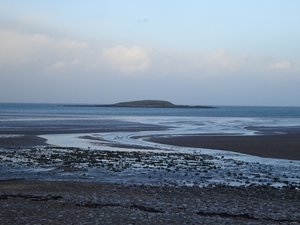
 St Patrick’s Island
St Patrick’s Island
Skerries
in my third Irish county, County Louth, bordering Northern Ireland to the north. Upon arrival I noted its lovely setting on the River Boyne, with the central part of town handsomely rising up over its north bank with church spires and other stately-looking buildings forming the townscape. My main purpose in visiting was to catch another bus heading five miles to the west to the amazing tourist attraction of Newgrange, more on that below. I had an hour-and-a-half before the twice-daily bus would take me there though, so I set about to explore this Irish town way off the tourist-beaten track – wonderful!
First up, I crossed the River Boyne from the bus station, and headed uphill towards St Peter’s Roman Catholic Church on the city’s central shopping street, West Street. This was another stunner of an imposing Catholic church, I had seen a few so far. Compared with Catholic churches in England which are generally quite modern and modest, it was interesting to see the powerful stature and age of the Catholic churches of Ireland. This one housed the relics of St Oliver Plunkett, once Archbishop of Armagh in the 17th century, which I believe made him the
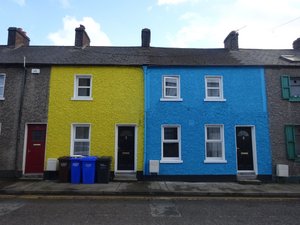
 Cute and Colourful Houses
Cute and Colourful Houses
Drogheda
leading Catholic churchman in the whole of Ireland at the time. He lived at a time however, when Oliver Cromwell of England came to Ireland, instigator and victor of the English Civil War of 1642 to 1651, after which the country briefly became a republic for 11 years until the reinstatement of royal rule again. Cromwell took an instant dislike to the Irish, and Catholics in particular, due to their support for Charles I during the war, and set about on a nine-month campaign in Ireland to subdue the country. This is often regarded as the beginnings of the oppression of the Irish Catholics, which continued for at least another 200 years, and has infamously caused issues in the country to this day. Drogheda was apparently treated really badly during this time. Due to his opposition to such treatment of Irish Catholics, Plunkett first went into hiding, and was then arrested in 1679. He was then taken for trial at Westminster in London, and found guilty of high treason in 1681, and a month later was hanged, drawn and quartered at Tyburn, at modern-day Marble Arch in London. Some of his remains, including his preserved head, are kept as relics
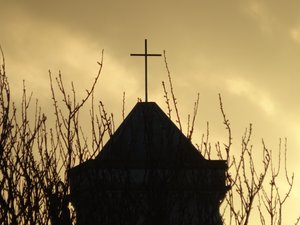
 St Patrick’s Church and Sunset
St Patrick’s Church and Sunset
Skerries
in St Peter’s Roman Catholic church, which I visited, but did not feel comfortable taking a photo of. It was really quite unusual to see such a thing on display in the church, but I can’t help but feel admiration for anyone who is willing to die for their beliefs.
After visiting the church and its relics, I headed eastwards along the main road towards the 13th century St Laurence’s Gate, the only remnant of the town’s once extensive 3km city walls after they were destroyed by Cromwell and his army in 1649. The man appeared to have a great distaste for the town of Drogheda in particular, and after destroying the town’s defences, an estimated 3000 people, including priests, women and children, were killed. Many survivors were sold into slavery in the Caribbean. It is in fact no wonder that I later learned this town is a bastion of Irish nationalist sentiment, and understandable given the hurt and the hardship caused here not so long ago. Despite this, I found the people of the town to be very friendly and welcoming.
After St Laurence’s Gate, I headed to the nearby Highlanes Gallery for a late (second) breakfast,
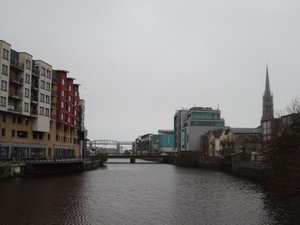
 River Boyne
River Boyne
Drogheda
a delicious full Irish breakfast, without the black pudding, and then walked back along the River Boyne to the bus station again to await my next bus.
There were in fact two places of interest near Drogheda that I wanted to visit, but since the only bus route to both ran only twice a day, I could only visit one, the amazing Newgrange centre. Fortunately though, the bus journey there afforded some great views of the other place, so at least I was able to take photos of the Battle of Boyne battlefield. It was interesting to find a link here between my Scotland travels last summer, and my Ireland travels here, for it was at this place the forces of James II (James VII of Scotland) fought the forces of William and Mary, for accession to the English-Scottish throne. The latter forces won, leading to the rebellions in Scotland known as the Jacobite Uprisings, written about in my Scotland blog entries. I was happy at least to be able to view the battle site from the bus, before it took me on to my main visit for the day – the amazing neolithic complex of “Brú na Bóinne”,
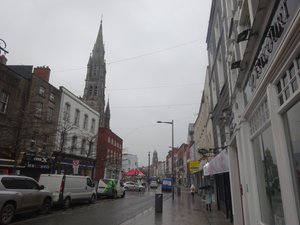
 West Street
West Street
Drogheda
or “Palace of the Boyne”.
This place was amazing, and I thoroughly enjoyed my time there! Although the site seemed stuck in a c-word time warp, with only around 20 visitors allowed in every hour, as opposed to their typical 2000 daily visitors at the height of summer, no gift shop open, and one-way systems still in place, I loved my time there immensely, and the quietness of the place certainly allowed for greater enjoyment. Fortunately I was able to book an online ticket a couple of weeks before my visit, for what looked like one of the last time slots available for that day, to also coincide with my midday arrival on the twice-daily bus – perfect! The visit involved firstly an hour around the Visitor Centre’s excellent museum, to get a background feel for the place and its history, and then a timed bus trip to one of the site’s three main passage tombs. Two of them are usually open to visitors, Newgrange and Knowth (not Dowth), but unfortunately at this time, they were only allowing visits to the former. I really could not see any c-word-related reason as to why, but nonetheless, I was happy to
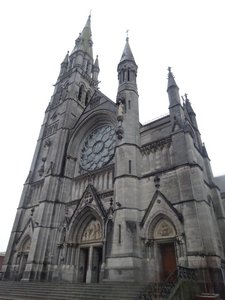
 St Peter’s Roman Catholic Church
St Peter’s Roman Catholic Church
Drogheda
be able to see the more famous of the three attractions at least. The bus took myself and 16 other visitors, including a very cool mature couple from Utah, USA, the two-mile trip up the hill to the really quite imposing and dominating Newgrange site. This passage tomb was built around 3200 BC, and actually predates both Stonehenge and the Egyptian pyramids. It is a huge 80m diameter, 13m high grass-topped dome, serving as a neolithic burial tomb for people of significant importance in those days. Not only is its size impressive, you can also walk through the passage into the tomb a third of the way through, into a cross-shaped inner chamber around six metres high and completely unchanged for thousands of years since it was built. There has apparently been no restoration of this inner chamber, and thus it exists as it once did 5000 years ago – quite remarkable really. And to top the amazement off, there is a gap in the rocks above the entrance, called the roof-box, which for only six days a year around the winter solstice, the rising sun lets in light all the way down the long passage to the inner chamber.
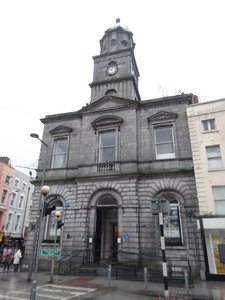
 Tourist Office
Tourist Office
Drogheda
Tickets to witness such a sight are allocated on a lottery-basis apparently, with 50 names drawn to see it each year, out of over 30,000 annual applicants. Whilst it was clearly not possible to see this, our guide allowed us a fabricated demonstration of what is seen on those days using electric lighting. This was impressive, and I can only imagine the wonder of seeing the real thing. Our guide took us into this inner chamber, along the 20 metre very narrow passage with numerous head-bumping possibilities along the way, as myself and the Utah gentleman found out. In there, you can still see etchings and engravings made by the stone-age people five thousand years ago. The most famous of these etchings is a trio of connected spiral circles, forming the main logo for the tourist site today. Whilst photos were not officially allowed, I followed a French couple’s cue and snuck in a few sneaky ones, including one of the trio of spiral circles – yay!
After our visit inside, we were allowed free time to walk around, which was done by many with great haste as it was an extremely windy day. In fact, on this day,
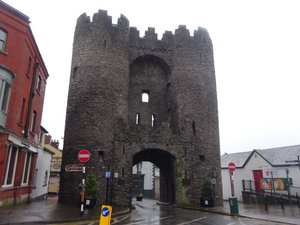
 St Laurence’s Gate
St Laurence’s Gate
Drogheda
Storm Dudley hit the British Isles, with winds of up to 80mph. On this exposed hill it was tricky at times to stand up, but I managed a circumambulation of the monument, before heading back to the bus where everyone was already waiting 20 minutes early for the ride back. Since everyone was there, the bus returned early, which although I would have been happy to spend more time in contemplation of the structure, I was also happy to be heading back to the Visitor Centre and out of the wind, rain and cold. I then had an hour before the twice-daily bus would pick me up again and take me back to Drogheda, and after the disappointment of learning that the gift shop was closed, due to my earlier point about the place being stuck in the dark ages of the c-word, I enjoyed a lovely vegetable soup, bread and latte at the café which was in fact open. Upon getting the bus back, while the wind was still strong, the sun had come out, and it remained glorious for the rest of the day.
After arriving back in Drogheda, I walked the mile or so from the
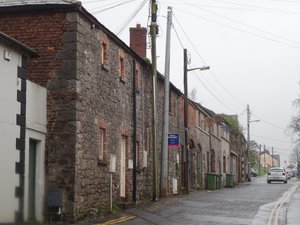
 Street Scene
Street Scene
Drogheda
bus station to the train station, where I was just in time for a train leaving to my final destination for the day, which the station guards were very friendly and held for me as I whizzed up the station stairs and across the bridge to get to the platform for. My final destination was one of my favourite in Ireland, the absolutely delightful little seaside town of Skerries.
Skerries, or Na Sceirí in Gaelic, meaning rocky islands, is both a seaside resort and a commuter town of Dublin, although it had absolutely none of the snootiness I found the previous day in Malahide. On my walk around town, I exchanged a cheery greeting with pretty much everyone I passed by (still no “top o’ the morning to yer”, but I guess it was nearly evening by then!). Despite Storm Dudley raging on, everyone was seemingly going about their business as normal here which was heartening to see – dog walkers, and families with children in playgrounds and even rock-pooling abounded, despite the possibility of nearly being blown off one’s feet! This reminded me of Yorkshire folk, who whatever the weather will still go about their business, often only
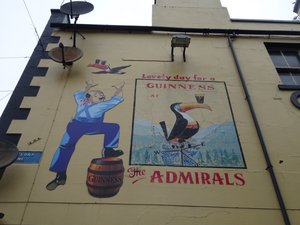
 Irish Pub
Irish Pub
Drogheda
in t-shirts or shirts.
My first visit in Skerries was to a place called the Skerries Mills, and although I arrived just as it was closing and thus unable to visit either its windmills or water mills, the owner was hugely friendly and welcoming, and allowed me all the time I wanted in the gift shop (I do like buying souvenirs…!), as he mentioned himself, “as long as you have a card to wave around, take all the time you need”! I did that, and although I initially only wanted to buy some postcards (which I never did manage to find despite three days of searching), I ended up spending a fair bit with some purchases I’m actually really pleased with – an Irish tin whistle, a shamrock made of Irish bog material, a Celtic cross, and a small picture showing the famous Irish Blessing “May the road rise up to meet you…”, which I just love. The lady behind the till seemed most chuffed, and kept me talking for pretty much my whole visit – I noted the Irish love to talk.
From here I headed towards the coast, and followed what is locally known as the
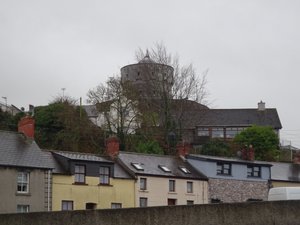
 Millmount Museum
Millmount Museum
Drogheda
St Patrick’s Way. I didn’t know this until my arrival, but one of the four rocky islands lying off the tip of the town’s very distinctive peninsula jutting out into the Irish Sea, is actually said to be the landing place of St Patrick’s first trip to Ireland as a free man, and is now aptly named Inishpatrick, or St Patrick’s Island. While you couldn’t visit it, or the other three islands, they were beautiful to see across the water from the town, made even more splendid by the spectacular colours of the setting sun, and particularly atmospheric by the gale-force winds. I learned from visitor boards around town about St Patrick’s relationship with the town. Originally an Englishman born around 385AD in Cumbria, Patrick was captured by Irish pirates at around 16 years old and taken into slavery in Ireland, working as a shepherd. After escaping and returning to England, he was inspired by a vision to return to Ireland, and to begin converting the Irish to Christianity. It is said that on his return journey, he first landed on this island just off the coast of Skerries, and you can apparently still see today “Saint Patrick’s Footprint” where
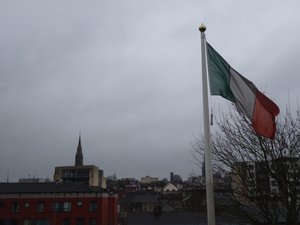
 Irish Flag over Drogheda
Irish Flag over Drogheda
Drogheda
he set foot again onto Irish soil on the island itself! Legend has it that he brought with him a goat, which provided him with milk and sustenance while living on the island, heading onto the mainland and back to convert the local Celts. The legend also goes that whilst on one of his missionary trips to the mainland, the people of Skerries stole his goat, and killed, cooked and feasted on it. This made Patrick very angry when he found out, and apparently he made two giant strides back to the mainland to find out what had happened. The local people lied and said they didn’t know what had happened to his goat, and as a result they lost their voices. The goat then apparently cried out from their bellies, making them tell the truth, and they then had their voices returned to them. What a legend, what a story!
I walked along the coast from the southern edge of town, all the way to the tip of the notable peninsula jutting out into the sea, and then back again along the northern side. The walk was highly exhilarating with the wind, and truly beautiful with the colours
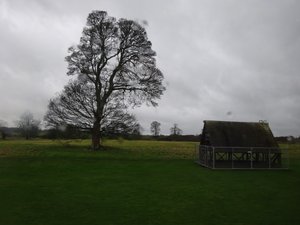
 Battle of Boyne Battlefield
Battle of Boyne Battlefield
Near Drogheda
of the setting sun, made even more wonderful by the exuberant friendliness of the local people. A lovely walk indeed!
After my walk, I found a bus stop, with half-hourly buses back to Swords. I noted that the next bus was due in 12 minutes, to a place called Carlton Court. I initially had no idea where this place was, until I realised it was actually the name of the street where my accommodation was on, and so how amazing that the next bus which would take me the hour-long journey back again would drop me off at a bus stop right at the bottom of my road, and a three-minute walk back to my accommodation – wow! I was initially planning to visit the Swords SuperValu supermarket for another ready meal to warm up in the microwave, but I saw the place of the next bus’s terminus as a sign to opt instead for a takeaway Domino’s pizza, since a Domino’s outlet was also at the bottom of the road of my accommodation not far from the bus stop, washed down with a glass of brandy. It was a wonderful ending to another wonderful day on the island

 Battle of Boyne Battlefield
Battle of Boyne Battlefield
Near Drogheda
of Ireland!
On my final morning, my flight was at midday, so I didn’t really have time to fit any more sightseeing in before heading home again. Instead, I said goodbye to the lovely owners of my accommodation, and headed to the airport, spending a relaxing few hours taking each of the airport stages gently and unhurriedly. I also contemplated and appreciated once more the striking tower of the airport’s very own church, Our Lady Queen of Heaven Catholic Church, which is one of the first things one sees outside the terminal building. I just loved the fact that arriving in and leaving such a spiritual and religious country, one is greeted by this welcoming sight. I didn’t set foot in the church though, but maybe I will on my next visit to Ireland. I also had no luck finding postcards even at the airport, so I opted for some arty Dublin greeting cards instead to send home, posting them in the airport’s resident post box.
The flight back was a breeze, and I was really very fortunate to have good flying weather on this day. The day before, Storm Dudley had battered the UK and Ireland with
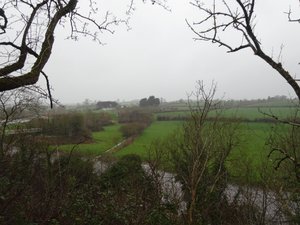
 Panoramic Vista
Panoramic Vista
Brú na Bóinne
80mph winds, and the day after came Storm Eunice, which brought some of the highest winds the UK has seen in recent years, with a record-breaking 122mph gust recorded for England on the Isle of Wight. The south-west, London and the south-east of the UK were all put on the Met Office’s Red Alert, which I have never experienced before, and indeed Friday was a very very windy day. All my patio plants blew over in one huge gust as I was looking out at them over a cup of tea, a neighbour’s roof tile came off, one of his wheelie-bins blew into the road nearly hitting a man, and a very large tree branch fell off a tree across the street from my house, literally seconds after a woman had walked under it (I saw this as I was writing my first Ireland blog entry in my front bedroom). A televised video of people being blown over actually came from Croydon town centre, while part of the 02’s roof actually blew off. This was one heckuva storm, and I count myself fortunate to have returned home on the calm day between the two storms. The same flight as I

 Newgrange from Above
Newgrange from Above
Brú na Bóinne
took on Thursday was cancelled on the Friday, and many planes touched down in roller-coaster-like conditions. Indeed, I was glad to be home before this day.
And so it is here that I end my write-ups of my lovely time in lovely little Ireland. It was a small taster of the country itself, and I do hope to be able to return for longer next time, and explore more. Nevertheless, I so much enjoyed my time there – lovely country, lovely people, and a lovely accent too! Thank you Ireland for my time with you, and thank you for being a wonderful country to become number 100 for me!
Thanks for reading, all the best, and until next time, which is scheduled to be a two-week trip around New England USA at the end of March (I plan to write up my blog entries for this one upon my return home), farewell for now! 😊
Alex
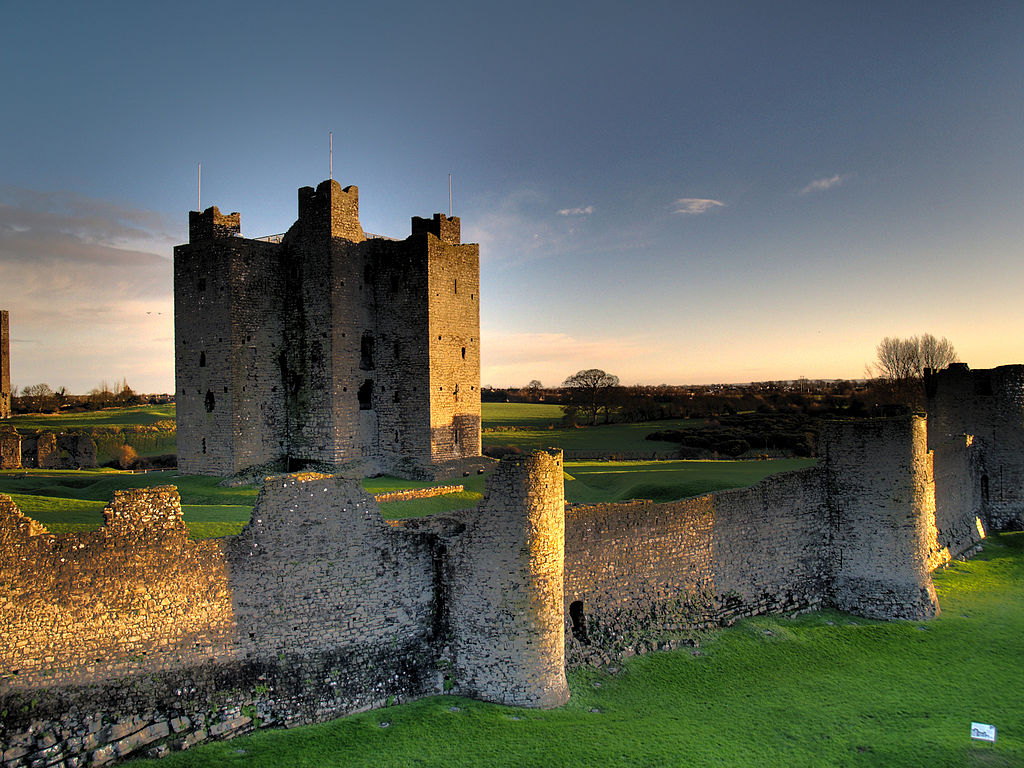
One response to “Ireland – Drogheda, Newgrange and Skerries”
comment